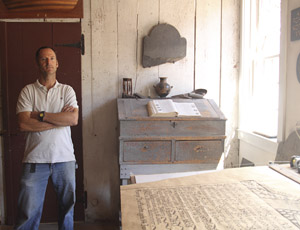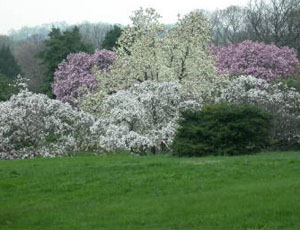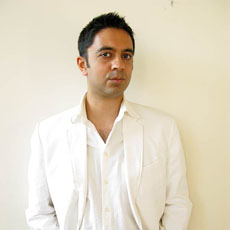2010-9-30
DOUG JOHNSON: Welcome to American Mosaic in VOA Special English.
(MUSIC)
I’m Doug Johnson.
Today, we report on this year’s MacArthur Fellowship winners ...
Answer a question about a huge and beautiful park in the nation’s capital ...
And play music from jazz pianist Vijay Iyer.
(MUSIC)
2010 MacArthur Fellows
DOUG JOHNSON: Receiving a telephone call from the MacArthur Foundation can lead to a big surprise. This week, the Chicago-based organization told twenty-three people that they had received a MacArthur Fellowship. Winners of this yearly honor receive five hundred thousand dollars with no conditions. The MacArthur Foundation says the program honors explorers and risk-takers doing interesting and inventive work. Mario Ritter tells us more.
MARIO RITTER: This year’s winners include scientists, artists, historians and language experts. Two MacArthur fellows pay special attention to letters. Matthew Carter is a type designer who creates letterforms for printed texts as well as computer screens.
He thinks about the way a letter’s design can be useful and also look good.

macfound.org
Nicholas Benson in his studio in Newport, Rhode IslandNicholas Benson is a skilled stone carver. Much stone carving of letters is done by machines today. But Mr. Benson’s artistry can be seen on buildings around the United States.
The youngest MacArthur fellow is thirty-year-old John Dabiri. He is a biophysicist who studies the special movement of jellyfish. His research is helping scientists understand evolution as well as the physics of fluids.
Entomologist Marla Spivak studies small creatures. Her work with bees is helping to protect these important insects.
Language is very important to both Jessie Little Doe Baird and Carol Padden. Ms. Baird has helped to bring back the language of the Wampanoag Indian tribe of Massachusetts. She has started a dictionary and an educational program to revive this language among her tribe members.
Carol Padden is a linguist who studies the organization and evolution of sign language. She has studied the social meaning of American Sign Language as well as the Al-Sayyid Bedouin Sign Language in Israel. She is the first deaf person to be named a MacArthur fellow.
Three fellows are interested in telling stories. David Cromer is a Broadway theater director who is presenting well-known twentieth century American plays in new and inventive ways.
David Simon is a television writer and producer whose programs explore the complex realities of city life. He is best known for his work on the shows "The Wire" and "Treme."
The writer Yiyun Li tells stories that take place in the United States and China. Her novel "The Vagrants" tells about life in a small Chinese town during the period after the death of ruler Mao Zedong in the nineteen seventies.
To learn more about the work of this year’s MacArthur fellows, look for a link on our website, 51voa.com.
(MUSIC)
National Arboretum
DOUG JOHNSON: Our listener question this week comes from Kazakhstan. Gennadiy Bydzan wants to know about the National Arboretum.
Many people who come to Washington are surprised when they first visit the United States National Arboretum. The Arboretum is only a short drive from the center of the city. But visitors often feel like they are far from the busy American capital. The National Arboretum is an active center for both scientific research and public education.

usna.usda.gov
Magnolias blooming in spring at the National ArboretumThe Arboretum covers one hundred eighty hectares of green space in the northeast part of Washington. It is famous for its beautiful flowers, tall trees and other plants. About nine thousand different kinds grow there.
An arboretum is a place where trees and other plants are grown for scientific and educational purposes.
The National Arboretum was established by an act of Congress in nineteen twenty-seven. Today, the United States Department of Agriculture’s Agricultural Research Service operates the Arboretum.
Its goal is to carry out studies and provide education in an effort to improve the environment. This goal includes protecting trees, flowers and other plants and showing them to the public.
As many as six hundred thousand people visit the Arboretum’s grounds each year. Hundreds of thousands also visit with the help of computers. They use the Arboretum’s Internet website to learn about current research programs and how to care for plants.
For several years, the National Arboretum has been collecting financial donations for an addition to the grounds. American and Chinese designers plan to build a traditional Chinese garden. The garden will cover an area of almost five hectares. It is a joint project between the United States Department of Agriculture and China’s Academy of Forestry.
The China Garden will include a lake, several smaller areas of fresh water and some traditional Chinese structures. The garden design is based on the traditional gardens in Yangzhou. China has agreed to provide the structures, artwork, rocks and other objects. It also plans to send experts to Washington to help build the structures. China says the garden will be a gift to the American people from the Chinese people.
(MUSIC)
Vijay Iyer
DOUG JOHNSON: Vijay Iyer is a jazz pianist, composer, producer and bandleader who has received much critical praise. Although he is under forty years old he has already released fourteen albums. Barbara Klein tells about the artist and plays some of his music.
BARBARA KLEIN:Vijay Iyer was born in nineteen seventy-one in Rochester, New York and grew up there. His parents had come to the United States from India. He started violin lessons at age three but he taught himself to play the piano.

Chris Drukker
Jazz pianist Vijay IyerThat worked out well. Here is an example from his first album, "Memorophilia." This song is called "Stars Over Mars."
(MUSIC)
Vijay Iyer graduated from Yale University with a degree in mathematics and physics when he was only twenty years old. He continued at the University of California, Berkeley, where he got a Ph.D in physics. He has spoken highly of his experiences playing jazz on the West Coast.
But he is based in New York City now. He performs all over the world and works with many different kinds of musicians and artists. In two thousand four he worked with poet Mike Ladd to make the album "In What Language?" It is a mix of spoken word and music. Here is "The Density of the Nineteenth Century."
(MUSIC)
Vijay Iyer is a professor at New York University, Manhattan School of Music and the New School. He also writes for music publications. His latest album, "Solo," was released a few weeks ago. We leave you with Iyer’s version of Michael Jackson’s "Human Nature" from "Solo."
(MUSIC)
DOUG JOHNSON: I’m Doug Johnson. Our program was written by Dana Demange and Caty Weaver, who also was the producer.
Join us again next week for AMERICAN MOSAIC, VOA’s radio magazine in Special English.